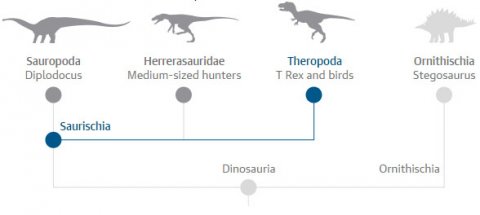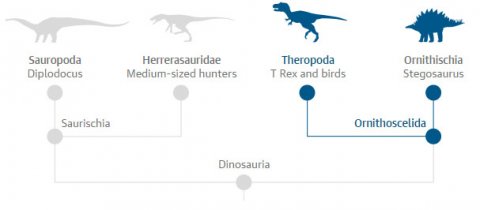A herd of Saltopuses chasing insects. The new study identifies Saltopus as the closest thing in the fossil record to what the hypothetical common ancestor of all dinosaurs might look like.
Illustration: Dea Picture Library/Getty Images/DeAgostini
The most radical shakeup of the dinosaur family tree in a century has led scientists to propose an unlikely origin for the prehistoric beasts: an obscure cat-sized creature found in Scotland.
The analysis, which has already sparked controversy in the academic world, suggests that the two basic groups into which dinosaurs have been classified for more than a century need a fundamental rethink. If proved correct, the revised version of the family tree would overthrow some of the most basic assumptions about this chapter of evolutionary history, including what the common ancestor of all dinosaurs looked like and where it came from.
Matthew Baron, the graduate student who led the three-year project at the University of Cambridge, said it would never be possible to pinpoint the origin of dinosaurs with certainty, but his findings might mean that they originated in Scotland.
Dinosaur family tree
Original groups
Traditionally dinosaurs have been divided into two main groups, Ornithischia (bird hipped dinosaurs) and Saurischia (lizard-like hips).

New organisation
Scientists have discovered that T Rex is more closely related to Ornithischia (Stegosaurus) and now lies within a new group called Ornithoscelida. Saltopus is positioned lower in the tree than the Dinosaura node at the bottom.

Saurischia
Dinosauria
Ornithischia
New reorganisation
Scientists have discovered that T Rex is more closey related to Ornithischia (Stegosaurus) and now lies within a new group called Ornithoscelida
Sauropoda
Diplodocus
Herrerasauridae
Medium-sized hunters
Theropoda
T Rex and birds
Ornithischia
Stegosaurus
Saurischia
Ornithoscelida
DinosauriaAs anticipated, the conclusions have been met with robust criticism from some rival scientists, including Max Langer, a respected palaeontologist at the University of São Paulo in Brazil.
Guardian graphic | Source: Natural History Museum
The conclusions have incurred robust criticism from some scientists, including Max Langer, a respected palaeontologist at the University of São Paulo in Brazil. “Saltopus is the right place in terms of evolution but you have much better fossils that would be better candidates for such a dinosaur precursor,” he said.
The findings also support the possibility that dinosaurs such as Stegosaurus and Triceratops, traditionally portrayed as tank-like armoured beasts, may have been feathered.
The central thesis of the new work is that a classification system, developed in 1888 by H. G. Seeley and generally accepted since then, is wrong. The system places dinosaur species into two distinct categories, Ornithischia and Saurischia, on the basis of the observation that dinosaur hip bones displayed either a lizard-like pattern (Saurischia) or a bird-like one (Ornithischia).
The Ornithischia group includes the relatives of Stegosaurus and Triceratops, while the theropods (such as T. rex), sauropods (such as Diplodocus) and another meat-eating group called Herrerasauridae, all fell within the lizard-hipped Saurischia group. Counterintuitively, the dinosaur group that later gave rise to modern birds (theropods) falls on the lizard branch of the family tree.
However, Baron says that, while this idea was brilliant for Seeley's time, it was based on very few specimens and is possibly archaic. While studying Stegosaurus-like dinosaurs, Baron noticed that, aside from the difference in hip bone configuration, there were a striking number of anatomical similarities between this group and the group T. rex belonged to, including the shape of the skull, hind limbs and ankle bones. Instead of focusing on the pelvic bone, Baron and colleagues at the Natural History Museum analysed 457 anatomical characteristics of 74 dinosaur taxa, using a statistical analysis designed to group the specimens according to the most likely evolutionary scenario. They found 21 anatomical features that lead to a different classification scheme for dinosaurs. Some of the common features shared between dinosaurs that were previously thought unrelated include straight thigh bones instead of the S-shaped ones found in some later dinosaurs, shoulder bones three times the length of the forelimb, and the first metatarsal – a long foot bone – not reaching the ankle joint.
The results suggest that theropods should be switched over to become an off-shoot of the same branch that led to Stegosaurus and Triceratops. The revised grouping of Ornithischia and Theropoda has been named the Ornithoscelida, reviving a name originally coined by the evolutionary biologist Thomas Henry Huxley in 1870. The revision would imply that carnivores evolved on two separate occasions and, according to the authors, strengthens the case for the initial ancestor being omnivorous.
Baron said it also raises the possibility that feathers first appeared in ancestors common to both the T. rex branch and the Stegosaurus branch of the family tree, which would be consistent with a number of fossils showing hints of feathers.
Langer argues that, while Saltopus might be statistically a good candidate for a common ancestor, given the patchy nature of the fossil it is a poor choice. Rather than attempting to identify the true ancestor of all dinosaurs – which can never be known – scientists aim to find an animal that is a decent approximation of the general form and traits displayed by that ancestor we know must have existed.
The fossil, found in a Lossiemouth quarry, comprises a pair of legs, some hip bones, and vertebrae, all of which have been badly squashed. “It looks like a chicken carcass after a Sunday roast,” Baron acknowledges.
The revised tree, if accepted, would also require the formal definition of dinosaurs to be re-written. The group is defined as all the descendents of the last common ancestor of birds (Theropoda) and Triceratops (Ornithischia), which have been historically on far flung branches of the family tree. But under the new tree, these two branches are closer together, technically placing all the long-necked herbivores outside of the dinosaur family.